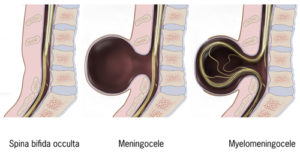Podcast: Play in new window | Download (Duration: 14:22 — 13.2MB)
Subscribe: Apple Podcasts | RSS | More
You get called down to labour ward to place an urgent epidural in a labouring nulliparous woman. When you get there the team inform you that “she is going crazy with the pain”, they can’t get her to hold still, they are having trouble monitoring the fetus and they are really worried she might be having an abruption. They plead “can you please do an epidural so we can get control of the situation?”.
The partner then tells you that she wasn’t planning on having an epidural because when she was younger she was told “she had mild spina bifida” He doesn’t know any other details but as long as he has known her – over 10 years – she has never had it looked into and he doesn’t think she has ever had surgery.
You glance at her back and notice a small dimple and a tuft of hair in the lower lumbar region and she looks like she might have a slight scoliosis, oh dear…..
This week I have managed to corner one of the rising stars in our department Gareth Ansell an anaesthetic provisional fellow in his final year of training. Gareth earlier in his career worked as a neurosurgical registrar before he saw the light and changed to the illustrious profession of anaesthesia, thus his interest in neurosurgical conditions and anaesthesia. Listen to this great 12-15minute interview where we cover all the important implications of how to assess & manage a parturient who has spina bifida.
Spina bifida can be associated with serious anatomical problems including tethered cord, lower than normal cord, Arnold Chiari malformations, and lack of normal epidural anatomy. These can predispose to some truly serious complications including neurological injuries, dural punctures, and failed or patchy regional blocks.

As an aside Gareth’s father is an obstetrician – who as it turns out was working in the small regional NZ town Rotorua at the time my twin sister and I were born and it is possible that he may have been the person who helped deliver me all those years ago! A small world.
Thanks Gareth – we are also in the process of working on another episode together – the use of sphenopalatine block for postdural puncture headache – including some exciting footage of Gareth placing lignocaine soaked swabs in my nasopharynx – watch this space!
